The first post in this series covered a very si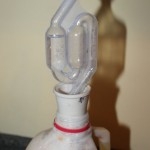 mple way to start the fermentation of hard cider where it was noted that sweet cider has a specific gravity of around 1.050.
mple way to start the fermentation of hard cider where it was noted that sweet cider has a specific gravity of around 1.050.
It has now been about 3 days and the cider has started up quite well and fermentation is really going well. The airlock is bubbling away letting of CO2 and the color of the cider is beginning to change as well as the pectin and tannins are beginning to settle out.
Now that we have a solid 1/2-gallon of cider full of active yeast culture, it would be a smart idea to transfer the remaining 4.5 gallons of sweet un-fermented cider to a fermenting vessel to begin the full 5-gallon batch.
In this case, I chose to use a 5+ gallon carboy which I cleaned and sanitized. I prefer Iodophor solution, but chlorine bleach or whatever you prefer should work just fine. After the carboy was cleaned and prepped, a large funnel with mesh filter was put on top and the remaining 4.5 gallons of sweet cider were transferred into the carboy.
After all the sweet cider was transferred into the carboy, the last step was simply to dump the 1/2-gallon “starter” into the carboy. Some people will advocate for “cold crashing” the starter so that the yeast go dormant and settle to the bottom. Then siphon off the liquid on top, and pour the remaining slurry of yeast directly into the fermenter, but frankly for this simple cider, I think it is unnecessary. Apparently, the starter liquid is “icky” or something like that, but I decided not to be so picky for this basic project.
As shown here on the left , the starter is bubbling away and is ready to be poured into the carboy with the rest of the sweet cider.
After pouring the starter into the carboy with the rest of the cider, I wrapped a heat belt around the carboy to warm it up. After coming up to around 70°F (21°C), I unplugged the heat belt and within a few hours the cider was bubbling away. As shown here, the thermometer reads about 66°F (19°C) which is what I tend to keep my house at in the winter.
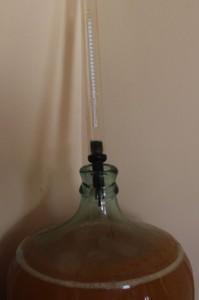 Since the sugars in cider are almost exclusively fructose, this means that the yeast will gobble up all the sugars until we are left with a final gravity of 1.000 and almost no apple flavor. Most people who enjoy hard cider do not (typically) enjoy very “dry” ciders like this. Often times, cider brewers will then re-sweeten the cider later, but I prefer option B: Stopping the yeast before it uses up all the apple sugar. This means two things:
Since the sugars in cider are almost exclusively fructose, this means that the yeast will gobble up all the sugars until we are left with a final gravity of 1.000 and almost no apple flavor. Most people who enjoy hard cider do not (typically) enjoy very “dry” ciders like this. Often times, cider brewers will then re-sweeten the cider later, but I prefer option B: Stopping the yeast before it uses up all the apple sugar. This means two things:
- Less calories and less alcohol (around 4% ABV)
- Monitoring the cider gravity
Frankly, I prefer a lighter, less alcoholic cider, so this is what I desire. In order to make certain that the yeast does not “go too far”, we have to take daily samples of the cider and measure the specific gravity.
Shown above is a “wine thief” — It allows the user to place a hydrometer inside and then snatch a sample of the cider (or wine) from the carboy (or cask) without moving or disturbing anything. Basically, it allows liquid to rush in through a bottom “valve” and then when lifted up out of the liquid, it closes the valve so that the hydrometer can be observed in the wine thief.
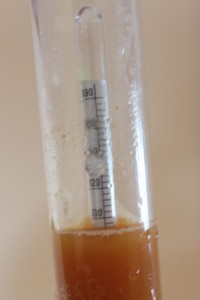 Looking closely at the hydrometer in the wine thief, we can see that the cider is currently at 1.034.
Looking closely at the hydrometer in the wine thief, we can see that the cider is currently at 1.034.
Dry Cider = 1.007 or lower Semi-Dry Cider = 1.008 - 1.014
Semi-Sweet Cider = 1.015 - 1.024 Sweet Cider = 1.025 - 1.034 Very Sweet Cider = 1.035 or higher
I usually target 1.012 – 1.014 for a hard cider that is the perfect balance of sweet and dry. Since we are at 1.034, it looks like we are a few days away from our target.
Next time: Stopping the Yeast.


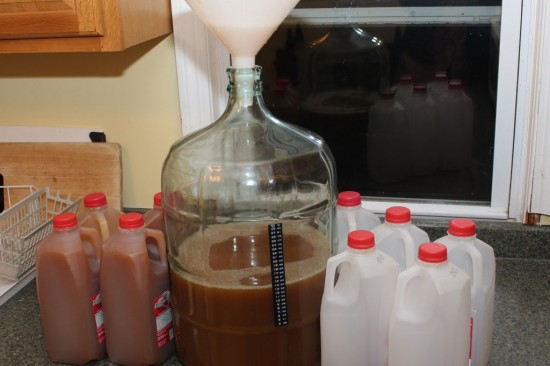
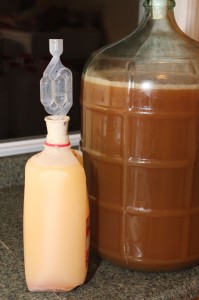
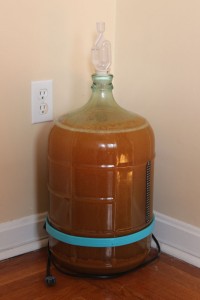
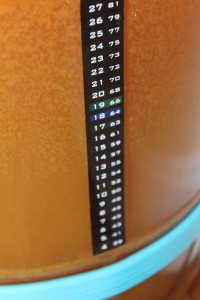
4 pings
Sweet Cider has a 1.050 specific gravity (or: How to brew hard cider) » Ranger Pretzel
February 1, 2014 at 6:24 PM (UTC -4) Link to this comment
[…] Monitoring the fermentation of hard cider (Or: How to brew hard cider, part 2) » […]
Stopping the cider fermentation and re-sweetening (or: How to brew hard cider, part 3) » Ranger Pretzel
March 3, 2014 at 11:44 PM (UTC -4) Link to this comment
[…] last post on brewing hard cider was on monitoring the fermentation. It was observed that after a week, the gravity was around 1.030 and it looked like it needed a few […]